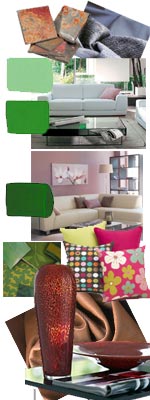Create A Mood Board
Before starting a decorating project, take the time to collect samples of your favourite materials and pictures of inspirational room designs. Spending time now planning a room should save time later on and help to avoid decorating mistakes.
To create a mood board
You can make a mood board from a sheet of cardboard, wood, poster board, in fact anything that will allow you to position paint swatches and still have room to add things like fabrics, wallpaper, border, etc, to see how the items you love tie together. The board should eventually be placed in the room where you intend to decorate - so you can spend a good deal of time looking at it in the daytime, at night, with lamps on and with candles burning.
Images that take your fancy
Cut out any pictures you like from magazines and books (not just interiors), and collect fabric and paint swatches. If you fall in love with a beautiful blue wall in a magazine picture, look at all the other elements that make up that particular room. Perhaps it has a beautiful oak floor or woodwork?
Arranging the mood board
Lay out your samples in the general order of the room - position the carpet at the bottom, soft furnishing samples in the middle, and curtain material near the top of the board. This will give you a much clearer idea than sticking samples randomly over the board.
Choosing the right shade
If you were to go for the exact same shade as you've seen somewhere else, would it look the same in your home? Think also about what you're using the room for - it may sound obvious, but you won't be able to relax in a riot of clashing colours.
Size of samples
The size of each sample should reflect how much space it will take up in reality, for example, have a much larger piece of paint swatch than cushion fabric. This way you can get an idea of how the colours and textures will work together.
You could make one for every room in the house.


